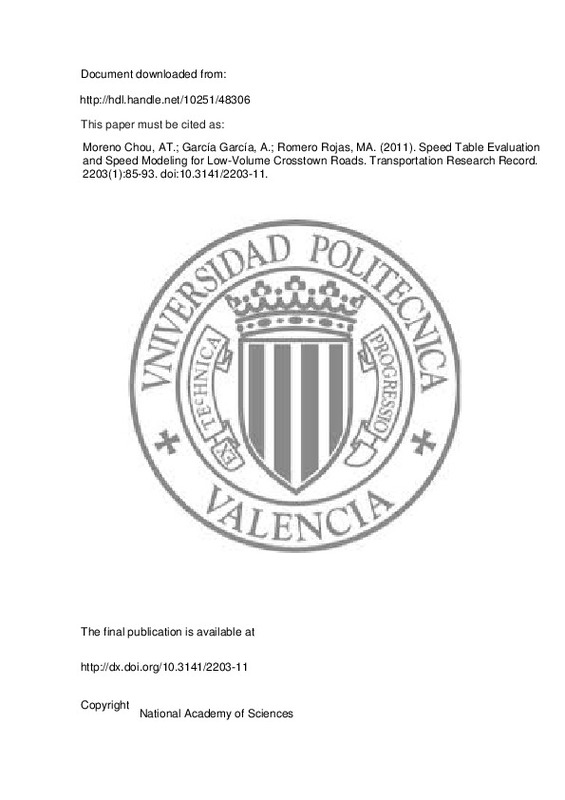JavaScript is disabled for your browser. Some features of this site may not work without it.
Buscar en RiuNet
Listar
Mi cuenta
Estadísticas
Ayuda RiuNet
Admin. UPV
Speed Table Evaluation and Speed Modeling for Low-Volume Crosstown Roads
Mostrar el registro sencillo del ítem
Ficheros en el ítem
| dc.contributor.author | Moreno Chou, Ana Tsui
|
es_ES |
| dc.contributor.author | García García, Alfredo
|
es_ES |
| dc.contributor.author | Romero Rojas, Mario Alfonso
|
es_ES |
| dc.date.accessioned | 2015-03-25T19:07:53Z | |
| dc.date.available | 2015-03-25T19:07:53Z | |
| dc.date.issued | 2011-07 | |
| dc.identifier.issn | 0361-1981 | |
| dc.identifier.uri | http://hdl.handle.net/10251/48306 | |
| dc.description.abstract | More than 50% of injury accidents in Spain take place on crosstown roads in urban areas. Traffic calming is an initiative to reduce the impact of traffic on local streets by lowering both the number and the severity of crashes. However, the implementation of traffic-calming devices in Spain was not standardized in the past, and no technical criteria were applied. The paper presents the methodology, results, and conclusions of an analysis specifically related to speed tables, which are flat-topped speed humps, as part of the research project MODETRA. For the research, five low-volume crosstown roads with 16 speed tables were selected to analyze drivers' behavior. Speed data were collected from a sample of more than 900 vehicles through the selected crosstown roads using Global Positioning System trackers. For each individual vehicle, a continuous speed profile along the path was obtained. The analysis showed that the minimum speed occurred when the vehicle left the traffic-calming device and the maximum deceleration occurred just before the device. Geometric characteristics of the speed tables were measured by using a digital profilometer. A wide dispersion in the geometry can be concluded. It was found that the speed reduction depended mainly on the separation between traffic-calming devices, whereas the speed over the speed tables depended crucially on the entrance-ramp slope, the speed table length, and the distance from the previous traffic control device. Also, no statistical correlations were found between speed table height and speed reduction or spot speed over the speed table. | es_ES |
| dc.description.sponsorship | The authors thank the Center for Studies and Experimentation of Public Works of the Spanish Ministry of Public Works, which subsidized the research. They also thank the Infrastructure and Transportation Department, General Directorate of Public Works, Valencian Government, Spain, and the Ministry of the Interior, General Directorate of Traffic, Spain, for their cooperation during data collection. | en_EN |
| dc.language | Español | es_ES |
| dc.publisher | National Academy of Sciences | es_ES |
| dc.relation.ispartof | Transportation Research Record | es_ES |
| dc.rights | Reserva de todos los derechos | es_ES |
| dc.subject.classification | INGENIERIA E INFRAESTRUCTURA DE LOS TRANSPORTES | es_ES |
| dc.title | Speed Table Evaluation and Speed Modeling for Low-Volume Crosstown Roads | es_ES |
| dc.type | Artículo | es_ES |
| dc.identifier.doi | 10.3141/2203-11 | |
| dc.rights.accessRights | Abierto | es_ES |
| dc.contributor.affiliation | Universitat Politècnica de València. Instituto del Transporte y Territorio - Institut del Transport i Territori | es_ES |
| dc.contributor.affiliation | Universitat Politècnica de València. Departamento de Ingeniería e Infraestructura de los Transportes - Departament d'Enginyeria i Infraestructura dels Transports | es_ES |
| dc.description.bibliographicCitation | Moreno Chou, AT.; García García, A.; Romero Rojas, MA. (2011). Speed Table Evaluation and Speed Modeling for Low-Volume Crosstown Roads. Transportation Research Record. 2203(1):85-93. doi:10.3141/2203-11 | es_ES |
| dc.description.accrualMethod | S | es_ES |
| dc.relation.publisherversion | http://dx.doi.org/10.3141/2203-11 | es_ES |
| dc.description.upvformatpinicio | 85 | es_ES |
| dc.description.upvformatpfin | 93 | es_ES |
| dc.type.version | info:eu-repo/semantics/publishedVersion | es_ES |
| dc.description.volume | 2203 | es_ES |
| dc.description.issue | 1 | es_ES |
| dc.relation.senia | 207274 | |
| dc.contributor.funder | Generalitat Valenciana | es_ES |
| dc.contributor.funder | Dirección General de Tráfico | es_ES |
| dc.contributor.funder | Centro de Estudios y Experimentación de Obras Públicas | es_ES |
| dc.description.references | Hallmark, S. L., Hawkins, N., Fitzsimmons, E., Resler, J., Plazak, D., Welch, T., & Petersen, E. (2008). Use of Physical Devices for Calming Traffic along Major Roads through Small Rural Communities in Iowa. Transportation Research Record: Journal of the Transportation Research Board, 2078(1), 100-107. doi:10.3141/2078-14 | es_ES |
| dc.description.references | Zuriaga, A. M. P., García, A. G., Torregrosa, F. J. C., & D’Attoma, P. (2010). Modeling Operating Speed and Deceleration on Two-Lane Rural Roads with Global Positioning System Data. Transportation Research Record: Journal of the Transportation Research Board, 2171(1), 11-20. doi:10.3141/2171-02 | es_ES |







![[Cerrado]](/themes/UPV/images/candado.png)

